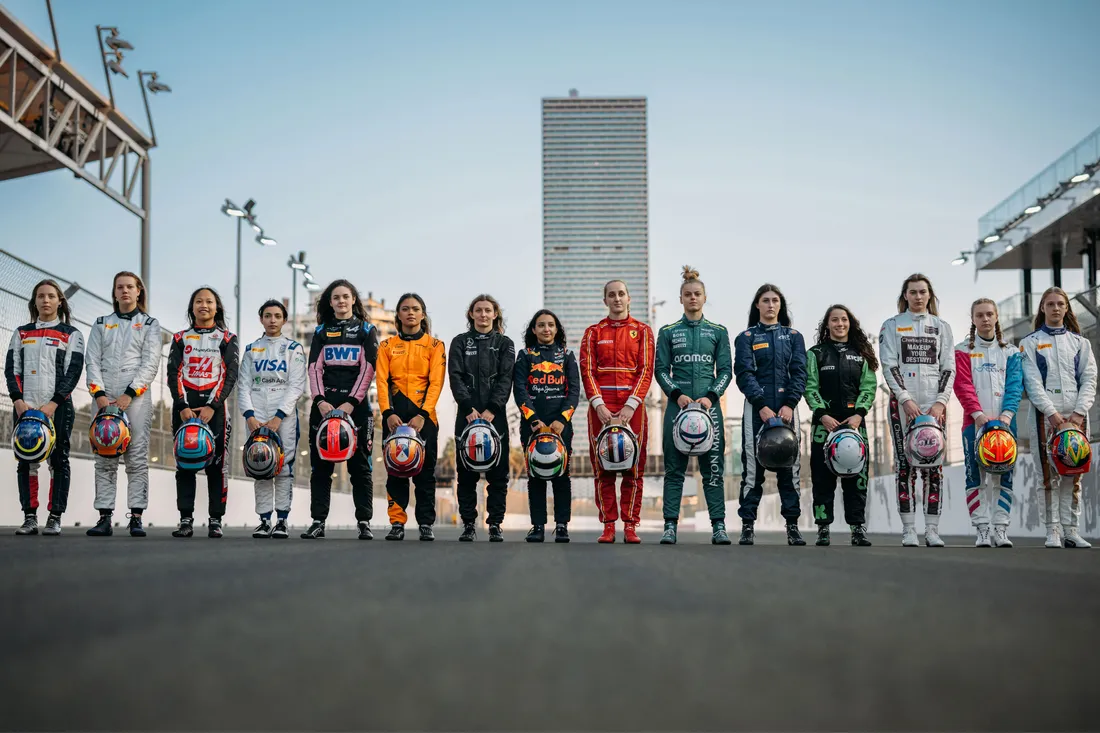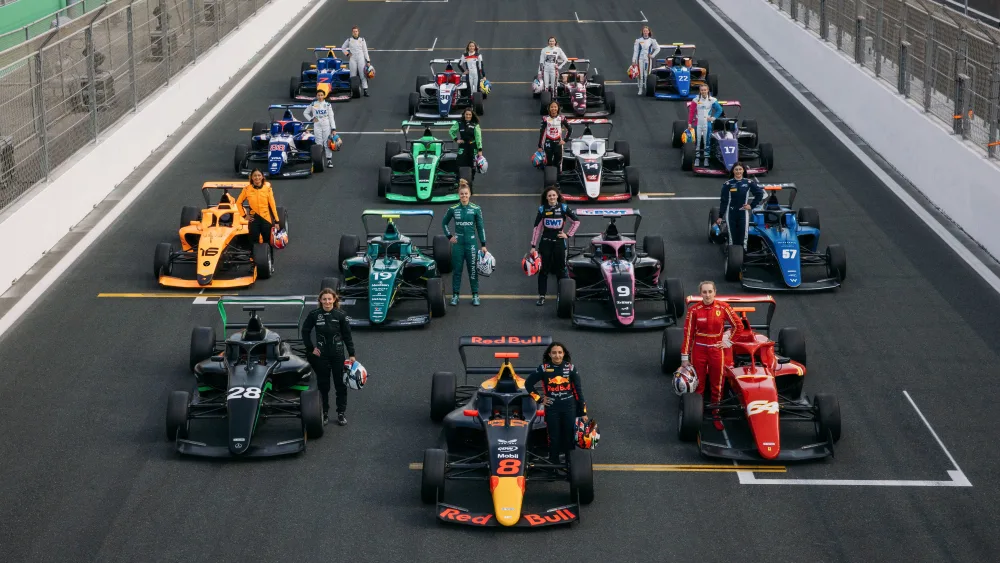F1 Academy Empowers Women and Shapes the Future of Racing
- Aslıhan Alp
- Aug 6, 2024
- 8 min read
Formula 1 (F1) racing has been a popular sport among different generations upon its debut in 1950. However, in recent years, motorsports have witnessed an expansion in its audience on a large scale with its fast and glorious world.
One of the leading factors behind this increase is the Netflix documentary series called “Drive to Survive” which narrates the events and stories of the pilots of each race season since 2019. With the impact of Drive to Survive, PR initiatives and the works of the influencers and content creators on social media, Formula series reached a wider audience, significantly with its female fans. According to the Chief Executive of Formula One Stefano Domenicali in 2022, female F1 fans were around 40% of all fans, up 8% from 2017.
“Some people argue that these PR moves are made not for gender equality but for money, and therefore, they are not genuine and won't be effective enough in increasing the number of women in sports. However, at the end of the day, if these moves are converting to upswings in data, I think they are worth doing. And from the annual surveys, we clearly see a rise in the women audience,” said Öykü Ceylan, Motorsports Journalist and Commentator.
Although there is an upgrowth in the female fan-base of F1, there haven’t been a female driver starting the race in F1 for 47 years, which is one of the rare sports where men and women can compete in the same race. In F1 history, only two women pilots, Maria Teresa de Filippis (1958-1959) and Lella Lombardi (1974-1976), have actually raced in World Championship events. Apart from their legacy to the sport, female drivers are only signed as a development and test drivers to the teams such as Susie Wolff for Williams Formula One and Tatiana Calderón for Sauber Formula One teams.
“I think this is an infrastructure problem. Therefore, I don’t think it is right to ask why there are no female drivers in Formula 1. Why aren't there any female drivers in Formula 2? Why is there only one female driver, Sophia Flörsch, in Formula 3? Or why are there no female drivers in Formula E, a racing series built entirely on the concept of sustainability? Especially when gender equality is a fundamental pillar of sustainability. The real issue is that there aren't enough women being trained for them to reach Formula 1,” said Ceylan.
Previous attempts for raising female drivers into the motorsports such as Formula Woman and W series, have unfortunately not resulted in them getting a seat in F1. To accelerate the trend of having female attention to the sport and give them a representation in F1, an all women “F1 Academy” was announced in November 2022 and started its operations in 2023. Susie Wolff, former professional racing driver, was designated the managing director of the series.
F1 Academy is a development program established as a part of Formula One’s commitment to support women in motorsports, nurture the next-gen drivers, and promote diversity and inclusion within the sport. Their primary mission is to provide a structured pathway to dedicated female drivers that will prepare them to climb up the higher levels in the motorsport ladder, including F1. This pathway includes honing driving skills, physical conditioning, mental preparation and technical knowledge and gaining essential experience.
“I believe F1 Academy is a very successful institution in addressing and taking action accordingly to the root cause of the problem which is the inadequacy of infrastructure. While their end goal is Formula 1, they are also working hard to develop a pool of female talent that will support both their own series and the sport in general. For example, with projects like ‘Discover Your Drive’, they are trying to start talent searches as early as age 8. You can't expect an 18-year-old woman to enter F1 Academy and become a Formula 1 driver within two years while all drivers on the F1 grid have been karting since they were three or four years old; it's just not fair,” said Ceylan.
On the current racetrack, five F1 Academy teams compete one another. These teams are called Rodin Motorsport, Campos Racing, Prema Racing, MP Motorsport and ART Grand Prix, their standings of the 2024 season so far respectively. Each team has 3 drivers and cars, making 15 drivers to race on the grid. For the 2024 season, the Formula 1 teams signed up 1 driver for F1 Academy and provided their own livery for the driver’s car to enhance their collaboration. Due to the fact that there are 10 teams in Formula 1, only 10 drivers out of 15 were signed by them. The remaining 5 drivers are supported by other partners of the mission such as Tommy Hilfiger, Charlotte Tilbury, American Express, Red Bull Ford and Puma.
Drivers who are between the ages of 16 and 25 are eligible for racing and they cannot do more than 2 seasons in the series. Correspondingly with the series’ goals, The Formula Regional European Championship (FRECA) grants a season-long fourth entry to the teams that sign a driver who finishes in top three in the final standings of the championship. Last year, Marta García became the champion of the first F1 Academy season with Prema Racing team and continued her professional career by proceeding in FRECA.
The current drivers of the grid are Lola Lovinfosse, Abbi Pulling, Jessica Edgar for Rodin Motorsport, Emely De Heus, Hamda Al Qubaisi, Amna Al Qubaisi for MP Motorsport, Chloe Chambers, Carrie Schreiner, Nerea Martí for Compos Racing, Bianca Bustamante, Aurelia Nobels, Lia Block for the ART Grand Prix, and Tina Hausmann, Doriane Pin and Maya Weug for Prema Racing. This year, Pulling is leading the championship with 147 points in 2 races so far.
The races are run in a Formula 4 car called Tatuus T421 with a modification on the rear wing, enabling the car to overtake smoothly. Drivers race their car on seven different tracks, Jeddah, Miami, Barcelona, Zandvoort, Singapore, Lusail and Yas Marina, in the order of the 2024 season respectively.
The calendar of 2023 season consisted of 15 official testing days and 3 races each for seven weekends, 21 races in total. However, Domenicali announced that F1 Academy races would take place on selected Formula 1 weekends along with Formula 2, Formula 3 and Porsche Supercup in the 2024 season. This induced a change in the race weekend format. Therefore, this season drivers race two times in one weekend instead of three by skipping the reverse-grid race.
F1 Academy and its success have become a source of inspiration to young women all around the world who have interests in motorsports. Some F1 drivers such as the seven-time world champion Lewis Hamilton have been praising and supporting the academy since its establishment. “She's [Wolff] really fighting for that inclusivity, so, I think it's really great the steps we are taking. Really happy to hear that all of Formula 1 is onboard,” said Hamilton in an interview about the support of the F1 teams.
Along with Hamilton, Ceylan also praises Wolff’s determined management skills, “What excites and reassures me about F1 Academy is the appointment of Susie Wolff as managing director. Wolff not only has personal success in motorsport but also has an outstanding experience in managing the FIA's ‘Dare To Be Different’ project. Knowing she has been successful in this position and cause before was definitely comforting.”
She also comments on the support the Academy receives from F1 drivers as “I definitely want to see more F1 drivers supporting F1 Academy and its drivers, because I believe this support is crucial for the future of the Academy. Bianca being frequently hosted in the McLaren garage during races or Hamilton visiting the paddock are great forms of support. I believe this will also be beneficial for F1 Academy's PR.”
Having the support of the media is another crucial aspect for raising awareness and attracting more audience to F1 Academy. Following the success of Drive to Survive, Reese Witherspoon’s production company Hello Sunshine announced in 2023 that they would be undertaking the creation of the docuseries about F1 Academy. A year later, it was announced that the fans would be able to stream the series on Netflix in 2025.
“It's not very realistic to expect the same level of success for the F1 Academy documentary as Drive to Survive. Drive to Survive had perfect timing; people were looking for content to consume during the pandemic. However, I still believe it will significantly increase the sport's popularity and the support it receives,” said Ceylan when she was asked if F1 Academy’s docuseries would achieve the success of Formula 1 Netflix series.
So, what can be done more to enhance F1 Academy’s success and women's representation in motorsports in general. Ceylan explains that while the underlying reason behind the lack of female representation in the upper ranks of the sport is due to infrastructure issues, another correlated reason is the lack of financial sponsorship. For example, one of the reasons Tatiana Calderón left Formula 2 was because she couldn't find enough sponsors.
“Therefore, the announcement of a major cosmetic brand like Charlotte Tilbury as a sponsor can be considered a milestone. To pave the way for seeing women in top positions like Formula 1, it is necessary to help women with sports budgets. Brands that appeal to women need to be attracted to the sport and provide more support so that women can achieve successful results with their talent, interest, and determination,” Ceylan elaborated.
Thus, it is important to work on projects to develop girls in the sport by starting them with karting at a young age, while also encouraging sponsors to expand their budgets on female pilots and, perhaps, creating funds for the longevity of projects in the motorsports industry, such as F1 Academy.
To join its purpose, motorsports fans can follow F1 Academy through its social media accounts, stream qualifying and the race sessions live on its Youtube and X channels or via F1 TV. In Türkiye, beIN Sports is the official broadcaster of F1 Academy.
What does the future hold for F1 Academy? According to Ceylan, F1 Academy is advancing very quickly day by day. She attributes the Academy’s success to its three pillars: community, youth engagement, and talent identification. “It is making great progress based on these pillars. For instance, it manages its community very well, making the series and the drivers accessible. As women, we feel close to them, see ourselves as part of them, and can engage with them. Regarding talent identification, they are constantly investing time, budget, and effort. Because of these core principles, they are improving themselves and the state of female representation in the sport continuously,” Ceylan said.
“I'm hugely proud of what we've achieved at this point. It's still just the beginning, I think there's a lot more we can do, but I can already see the positive impact we're having and that's something which is reassuring to know that we're on the right path,” commented Wolff in an interview with F1 on the Academy’s ongoing success. “Obviously, we’ve seen from the world of karting the impact we can make when we try to generate more female talent. For me, it’s about onwards and upwards. We’re off to a solid start, but we want to make sure that we are creating more opportunities, inspiring the next generation, and impacting this sport for the better,” she added.
F1 Academy has a bright future ahead with its major progress in only one year, such as taking the broadcasting rights of the races and taking in big sponsorships. It will strengthen the loyalty of the female audience to the sport, and perhaps, attract new blood in the future gradually.






